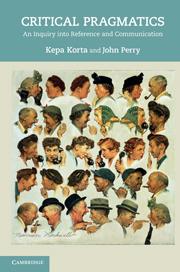Book contents
- Frontmatter
- Contents
- Preface
- Acknowledgments
- 1 Introduction
- 2 A short history of reference
- 3 Acts, roles, and singular reference
- 4 Elements of reference
- 5 Demonstratives
- 6 Context sensitivity and indexicals
- 7 Names
- 8 Definite descriptions
- 9 Implicit reference and unarticulated constituents
- 10 Locutionary content and speech acts
- 11 Reference and implicature
- 12 Semantics, pragmatics, and Critical Pragmatics
- 13 Harnessing information
- 14 Examples
- Bibliography
- Index
3 - Acts, roles, and singular reference
Published online by Cambridge University Press: 05 March 2013
- Frontmatter
- Contents
- Preface
- Acknowledgments
- 1 Introduction
- 2 A short history of reference
- 3 Acts, roles, and singular reference
- 4 Elements of reference
- 5 Demonstratives
- 6 Context sensitivity and indexicals
- 7 Names
- 8 Definite descriptions
- 9 Implicit reference and unarticulated constituents
- 10 Locutionary content and speech acts
- 11 Reference and implicature
- 12 Semantics, pragmatics, and Critical Pragmatics
- 13 Harnessing information
- 14 Examples
- Bibliography
- Index
Summary
Introduction
Our approach to pragmatics emphasizes that utterances are acts and language is action. But of course it is a special kind of action; it paradigmatically involves communication of information. (We use ‘information’ rather loosely, basically as meaning ‘information or misinformation.’ When we use it more strictly, as implying accuracy or truth, we'll alert the reader.) Basically, the speaker is the agent, communicating information to the hearer. (We also use ‘speaker’ and ‘hearer’ loosely, to include producers and readers of written texts and users of sign languages like ASL.) The hearer is the interpreter. The link between them is the sign, the linguistic token. The speaker intentionally produces it, the hearer perceives and interprets it. In this chapter we say a bit about the picture of actions and signs that underlies our version of the Gricean picture.
Acts and actions
Acts (particulars) involve agents at times and locations performing mental operations, and moving their bodies, limbs, and other body parts, including vocal cords, in various ways, which they can do at will. Such basic actions we call ‘executions.’ The basic actions one executes at will have various results, depending on the circumstances in which they occur. The actions have a direct effect on objects that play various roles in the agent's life, like the computer key he is touching, or the person he is talking to, and as a result may have more and more remote effects.
- Type
- Chapter
- Information
- Critical PragmaticsAn Inquiry into Reference and Communication, pp. 25 - 36Publisher: Cambridge University PressPrint publication year: 2011



